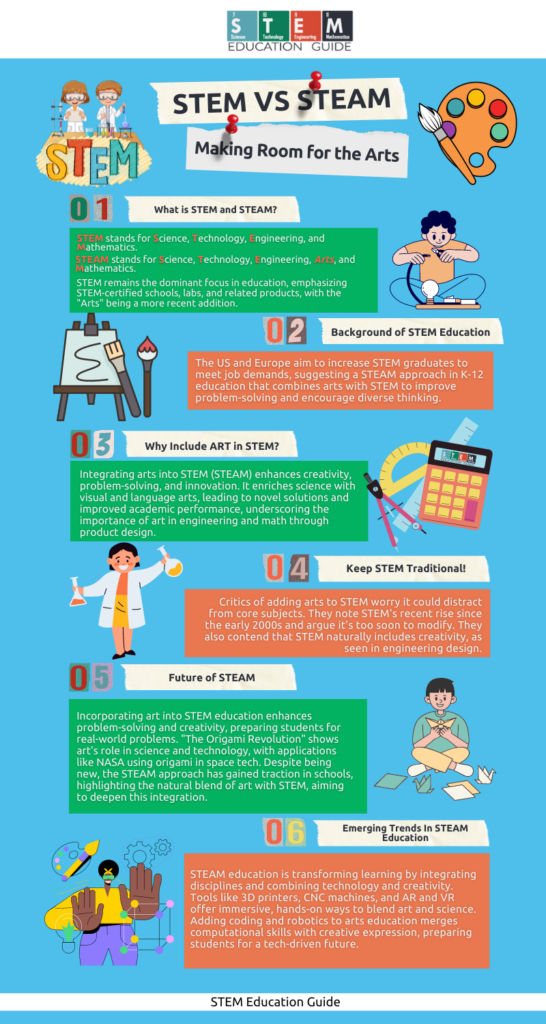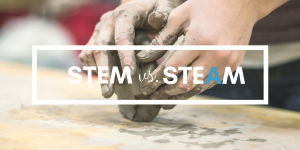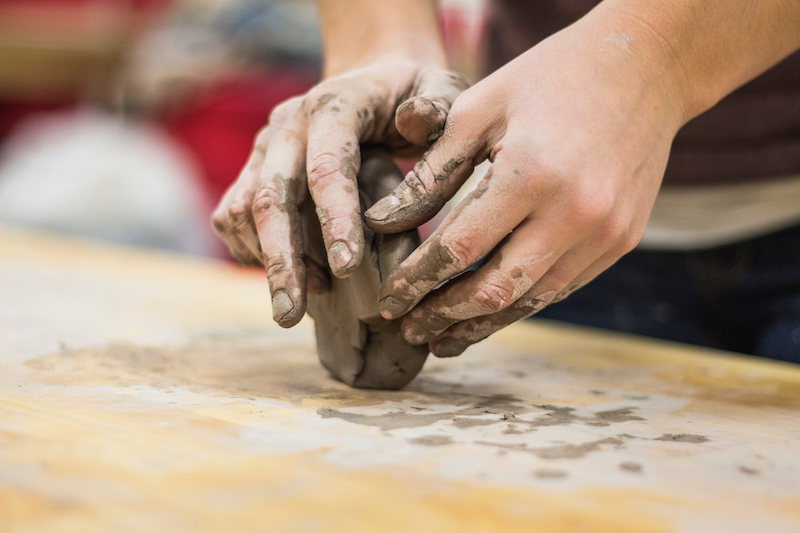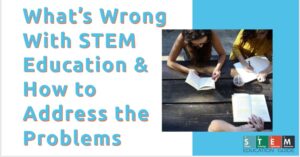STEM stands for science, technology, engineering, and mathematics.
STEAM stands for science, technology, engineering, arts, and mathematics.
STEM is still the more prevalent acronym in education, with a focus on STEM-certified schools and STEM labs and entire categories of STEM-related educational products, while the “Arts” are a recent addition.
While the arts are an important part of education, is there enough synergy to merge the arts and sciences, especially when considering educational funding and STEM grants?
In this article, we’re looking at both sides of the argument. Should the arts be included in STEM education?
First, a bit of background on STEM education.
The US and Europe have been pushing for an increase in STEM (Science, Technology, Engineering, Math) graduates to fill the growing demand in STEM careers. Both educators and professionals involved in STEM-related fields have advocated for the introduction of a STEAM curriculum, which enriches STEM subjects with the visual and language arts, to K-12 education, aiming to foster a well-rounded education.
Integrating arts into STEM lessons not only broadens the curriculum but introduces students to new ways of thinking and problem-solving, preparing them from an early age for future challenges.
This paramount shift that STEAM proposes yields both staunch proponents and detractors.
STEM Education Guide Pro-Tip: When considering the integration of arts into STEM, think beyond traditional art forms. Incorporate design thinking, creativity, and innovation processes into STEM projects to develop students’ soft skills alongside their technical skills, making them more adaptable to the real world. This approach enriches the curriculum and prepares students for real-world problem-solving, a critical skill in navigating the complexities of the modern world.
Table of Contents
The Fifth Element: Why include Art with STEM Education?

The bonding of the four pillars of STEM feeds upon one another. Science and math feed directly into technological and engineering applications and the arts, giving STEAM education additional benefits.
It’s not enough to teach each one individually; they are all included in a single acronym for a reason. Engaging young people in STEM education through the addition of arts fosters a more inclusive and engaging learning environment.
You can’t build a rocket, car, watch, or even a bicycle without an understanding and the application of principles from all these areas.
STEM is fundamentally connected to everything in our society, and we must help students see those connections.
The new element being championed today is the addition of arts, particularly visual arts, which are pivotal in enhancing STEM education by promoting creative thinking and problem-solving skills, crucial components of a STEAM lesson. Those in favor of STEAM recognize the ability of the arts to expand the limits of STEM education and application.
The inclusion of new media arts into STEAM education represents a forward-thinking approach, enhancing traditional scientific concepts with innovative digital tools and platforms.

Advocates point to the added innovation and creative thinking that a strong foundation in the visual and language arts can provide, arguing that these elements are essential for a comprehensive STEAM curriculum. The president of Rhode Island School of Design (RISD), a leading advocate for the integration of arts into STEM, says that opening the door to the arts aids in the process of turning critical thinking into critical making.
What is STEM if it is not about taking some idea and applying an understanding of these pillars to making something?
Studies have also proven that students with a strong foundation in arts perform better academically as a whole. The University of Florida found that “on average, students who study the arts for 4 years in high school score 98 points higher on the SATs compared to those who study the same for half a year or less.”
The conclusion stated that “students who took up music appreciation scored 61 points higher on the verbal section and 42 points higher on the math section.”
For proponents of STEAM, integrating the arts is a no-brainer. After all, you can’t make an eye-popping sculpture or build jaw-dropping architecture without engineering and mathematics.
Cars are judged not only by the technology and engineering features they possess but also by their design and aesthetic qualities- which again is backed by engineering and mathematics.

The Opposition: Keep STEM Traditional
Merging the arts with STEM seems great. However, there is still a vocal group that opposes integrating the arts.
Chief among the concerns is that adding arts to STEM programs will dilute the study of these much-needed fields.
While science, technology, engineering, and mathematics have naturally been linked for some time, STEM wasn’t a widely recognized term until the early 2000s. It wasn’t until 2005 that STEM really gained momentum and got its own caucus in Congress, and it wasn’t until 2008 that it actually started grabbing headlines. Opponents to the STEAM movement say that the STEM initiative is still too young to add another component.
Another disagreement is that STEM has no shortage of ingenuity and creativity. Engineers have regularly integrated design into their work.
What is the future of STEAM?
Applying art to science, technology, engineering, and mathematics in the classroom is only the first step towards cultivating problem-solving skills and creative thinking, key aspects of a STEAM lesson that prepares students for challenges in the real world.
If you are still skeptical that art can be applied to cutting-edge science and technology, then look no further than The Origami Revolution which recently aired as part of PBS’s NOVA program. The episode outlined the development of computer software written by Tomohiro Tachi, who collaborated with Erik Demaine that used origami algorithms to design two-dimensional crease patterns to create any three-dimensional object from a piece of paper.
Neither of them is an artist; Erik Demaine is a mathematician at MIT, and Tomohiro Tachi is a professor at the University of Tokyo with expertise in civil engineering. The interdisciplinary nature of STEAM, which includes social sciences, illustrates how blending different disciplines like mathematics, engineering, and the arts leads to innovative solutions, showcasing the importance of a diverse educational approach.
That alone is a testament to the value of art in the sciences but its application goes well beyond origami.
Using this type of computer modeling has big implications for traditional STEM endeavors. NASA, for example, can use methods derived from origami to develop solar panels that fold into space and weight-saving packages during launch, which then unfold into a massive solar array once in space.
In robotics, adding cuts into origami designs enables them to transform from flat to functional three-dimensional tools. And the list goes on, even in the medical field.
STEM Education Guide Pro-Tip: Schools and educators looking to adopt a STEAM approach should start small with collaborative STEAM projects between art and science teachers. This encourages a culture of innovation and shows how subjects interconnect, making learning more engaging and applicable to students’ lives.
The STEAM movement is still relatively new and in its formative stages. That is not to say that STEAM programs have not already found success. From the aforementioned RISD, to the Blue School in New York City, to the Drew Charter School in Atlanta, several schools have already implemented respected curriculums based on STEAM, and many more pop up yearly.
Additionally, some artists are tackling the integration from the other end of the issue, working to bring the arts closer to science in their own way. Even the iconic children’s education program, Sesame Street, added STEAM to its program for its 43rd season in 2012.
One thing that both sides can agree on in the STEM vs. STEAM debate is that art has organically found its way into STEM fields. Proponents of STEAM only want to make this integration more prominent.
Emerging Trends in STEAM Education
As we go forth, the educational landscape continues to evolve. Emerging trends in STEAM education are bridging the gap between these disciplines and pioneering innovative approaches to students that prepare them for a future where technology and creativity intersect more seamlessly than ever before.
A trend I’d like to bring up is the increasing incorporation of digital fabrication tools like 3D printers, laser cutters, and CNC machines into the classroom.
These tools let students bring their digital designs to life, offering a hands-on learning experience encompassing artistic design and scientific calculation. Not only is digital design cool, but this melding of creativity with technical skills underscores the essence of STEAM education, where students are encouraged to think critically and innovate.
Another trend is using augmented reality (AR) and virtual reality (VR) in teaching scientific and mathematical concepts through immersive experiences. I know most of us have heard about these all our lives, but it’s really just getting interesting now with current tech.
For instance, AR can overlay data onto the physical world, helping students visualize abstract scientific concepts in real-time, while VR can transport students to virtual labs or historical sites.
Also, using coding and robotics in arts education introduces students to the language of the future — programming.
By creating artworks or musical compositions through coding, we can learn computational thinking alongside artistic expression, a skill set that will only become more important.
We are well aware of problems with STEM. In our article, What’s Wrong With STEM Education: How to Address the Problems. We address the real issues and offer solutions on how to fix them.










Very good article. I don’t believe there should be China wall between STEM and Arts. That brings a lot of questions especially for younger people when it comes to choose a pathway especially when want to go to college. Reading your article I am siding toward STEAM as I believe it offers a more rounded skill set at the end of the day.
Today’s students are tomorrow’s pioneers. Occupations in STEM-related professions are probably the quickest developing and best paid of the 21st century, and they frequently have the best potential for work development. The most ideal approach to guarantee future achievement and life span is to ensure that the students are well versed in these subjects.
Building a strong STEM Foundation through a balanced educational plan is the most ideal approach to guarantee that understudies are presented to math, science, and innovation all through their instructive profession.
“If we want a society and culture that work for everyone, we need innovation in our relationships along with innovation in the STEM fields and STEM education”. The craze for STEM Learning has now significantly increased in young students. The universities are coming up with various STEM Learning Programs in collaboration with other institutions & researchers. Thanks!!
This is a great unbiased primer to the STEM vs. STEAM debate. I think the key here with the opposition to the inclusion of “arts” is what exactly “arts” has become in this day an age. Musical composition and performance, detailed sculptures, technical drawings? Great, that’s absolutely arts, and should be part of STEM/STEAM. Throwing paint blotches at a canvas? Hanging a chair on a wall? Tossing trash on the floor? Those are considered modern art, but how do they have any relation to the classical technology-driven definition of STEM? How can you identify something like that as true innate creativity and talent vs. just creating something and hoping it becomes popular? I believe it’s the perceived addition of those types of ambiguous pseudo-creative pursuits to the core technical talent required for the original components of STEM which is what drives the severe opposition to adding Arts to STEM. The other argument I have heard is “art is more accessible to minorities.” Which also goes entirely contrary to the original focus of STEM. In summary, if we could agree on what the “A” in “STEAM” represents — technical artistic work — then using “STEAM” would be much more accessible and agreeable to its opponents.
I agree that arts can be a valuable component of education, and frequently use art projects to show how science works with my grandchildren, and perhaps the inclusion of art in this context would provide value by giving children a deeper level of understanding of technical concepts and therefore less anxiety when one says ‘calculus’ or ‘physics.’
However, the reason that so many opportunities exist in STEM fields is because not enough children, teenagers, and young adults are being given strong enough backgrounds in math and sciences to succeed in the “hard” curriculums when the time comes to make decisions regarding higher education.
Even when I was a junior at university in the 1990’s and was a mentor for incoming engineering students, many were intimidated by the expectations at the university level. I can’t help but feel that a more comprehensive integration of math and science from an early age would ease that fear and encourage more people to explore technical education options.
I feel this is mostly for universities to find ways to make sure their arts programs continue to make money. Combining engineering with some form of painting/music is a good way to keep the coffers flush. If we add the “A”, isnt it just Arts and Sciences like almost all universities offer classes.
The focus on STEM is to get kids to take rigorous technical courses which may not be for everyone.
I think Freedom to the people has a pretty narrow view of STEM learning and of the Arts. A wide view of STEAM Learning and how it applies to our children across the country shows that teaching these disciplines in a collaborate style allows for a larger number of students to connect and learn at a much higher level. Then when they enter the workforce (whether right after high school or an extended university experience) they are better equipped to excel in all fields.
STEAM should not sound like a new concept, but rather a realistic view of what education should include to produce students who are real world learners capable of adapting to real world problems. One of the founding principles of STEAM is that of problem solving collaboratively. In the medical field, so many unknowns still exist, even in our advanced hospitals of today. The thought that your doctor relies only on science and technology firmly in place instead of allowing for inquiry and problem solving of innovative procedures and medicines is a scary and somewhat sobering thought. STEAM advocates for this type of inventive process in addition to, not in place of, the standard protocols and procedures in place. The mind flourishes when involved with the arts. To exclude the arts from any educational structure is a disservice to the minds and humanity of those it serves.
Stem is required, arts are just the aesthetics so completely different, and the only subjective one. It doesn’t make any sense. I can see why arts practitioners would like to be included among the others, of course, but it’s diluting science making people think it’s a matter of opinion.